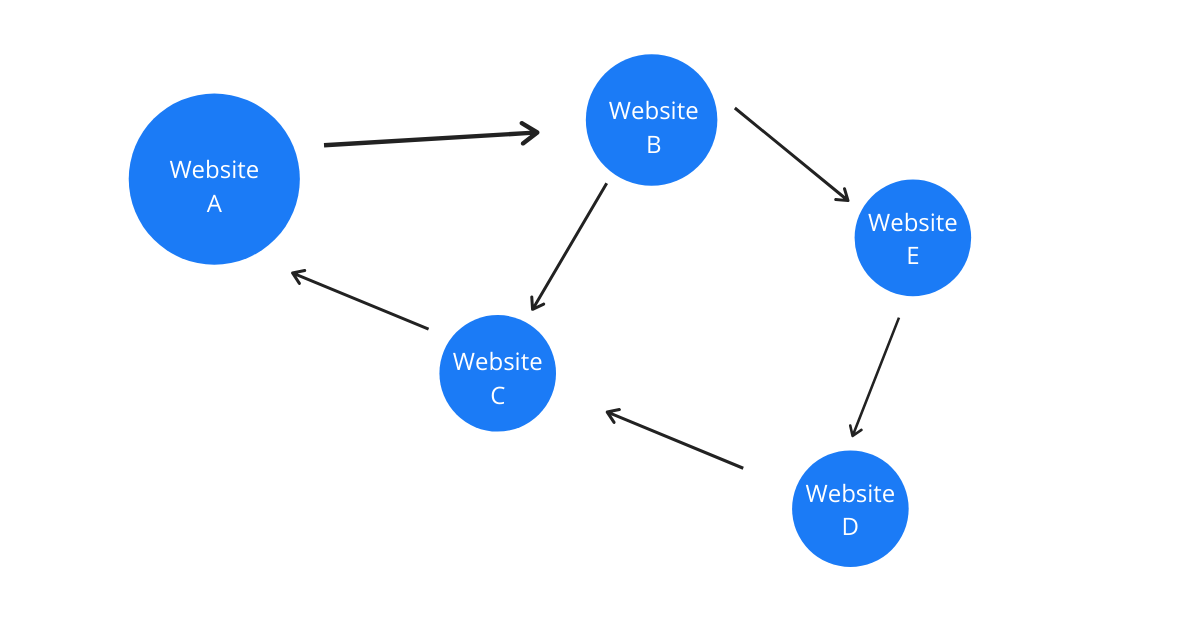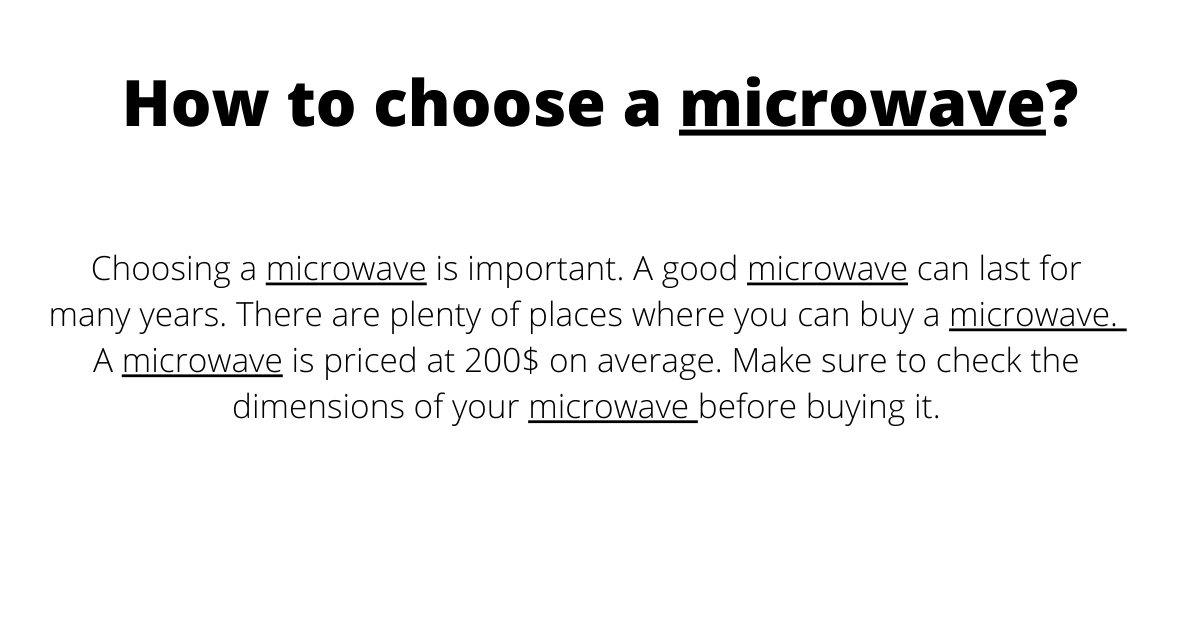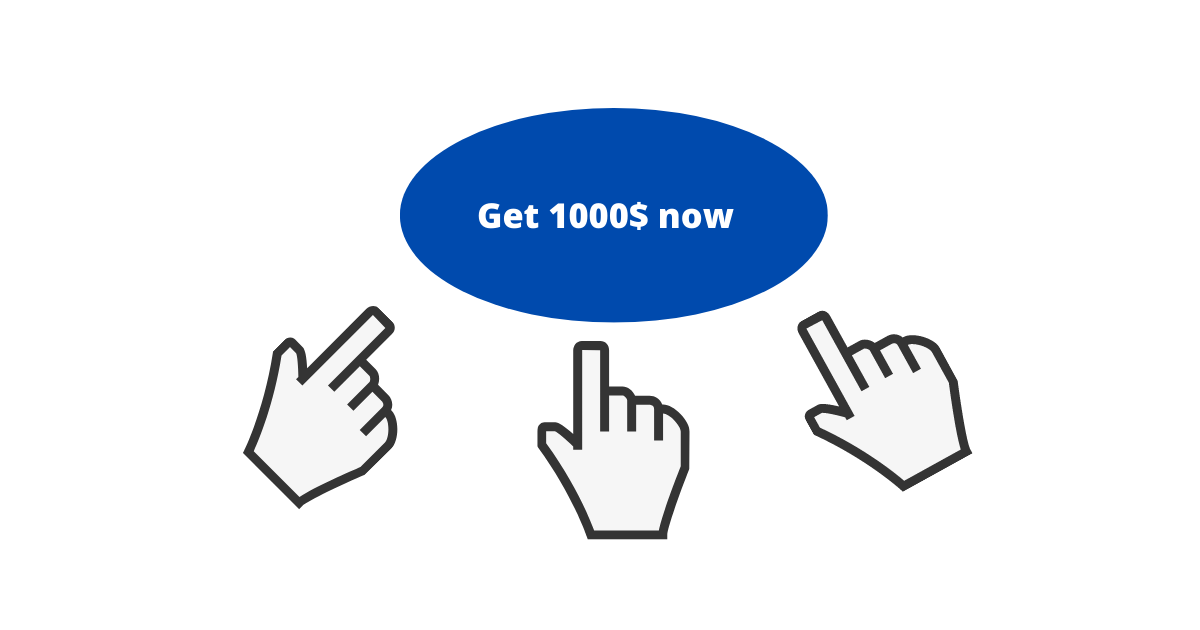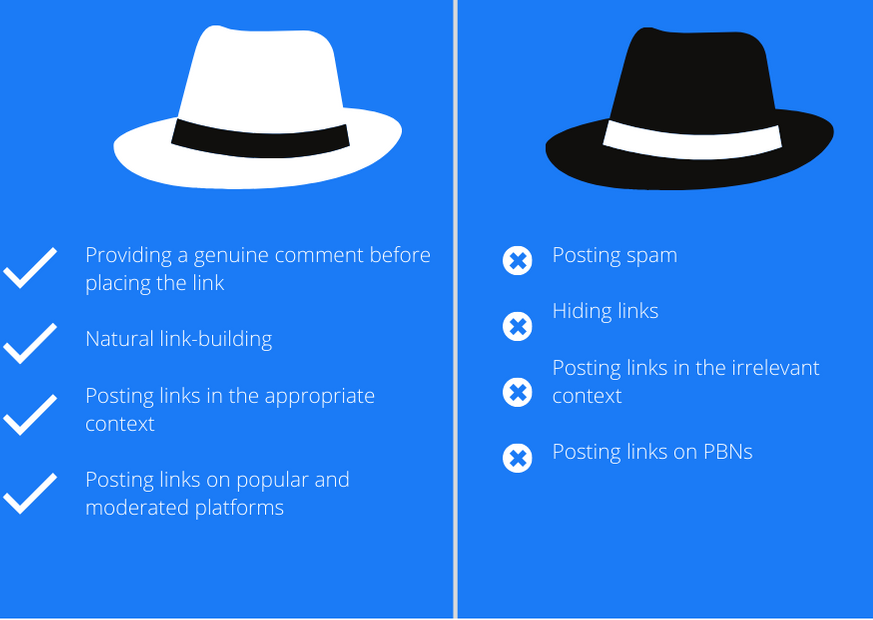You’re probably familiar with the ambiguous terms like Black Hat and White Hat SEO (and you may be wondering what it has to do with hats). Today we’re going to break them down and explain the differences between them.
This is your complete guide to White Hat vs Black Hat, where we addressed all of the techniques used for SEO (the good, bad and ugly). Seriously, we tried to gather most of them.
What is Black Hat SEO?
Black Hat SEO refers to the “unethical” techniques, used by marketers to increase their search ranking. Those include, but are not limited to:
- Link farming – having a whole network of websites, intended solely for the purposes of link-building. They are similar to PBN and tend to have low-quality content, low incoming and similarly, low social signals.

- Hiding links – one of the oldest SEO hacks, that was abandoned for a long time (thankfully). For example, you could hide a link by making the text white and placing it on a white background.
That way your readers don’t see it, but the catch is… Google does! And as soon the page is indexed – you get a penalty for your SERP ranking.
- Keyword stuffing – simply repeating high-volume keywords, regardless of whether they fit the context. This practice was hit hard during Google Panda update, and you should avoid using it.
Instead, focus on the reader, choose synonyms and don’t repeat the same keyword in every 2nd sentence of your article.

- Auto content – having a piece of software writing content for you (an example would be a plugin called WP AutoContent). First off, that usually ends up not readable and not very relevant for your audience, as machines are still limited in their predictive power.
Secondly, this software usually steals other people’s work bit by bit and combines those fragments together to produce a “new” piece of content. This actually violates multiple search engine guidelines and should be avoided, as that kind of content is really not aimed towards the user.

- Cloaking – another widely known black hat SEO tactic, where you would display two separate pages – one for website crawlers, and another one for users.
This is quite advanced, as you’d have to manipulate Google crawlers by identifying their IP and serving them a different version of the webpage. However, Google gets smarter every year, and nowadays they can detect cloaking relatively easily.

- Plagiarism/ duplicate content – this one is fairly obvious. You shouldn’t copy other people’s work. You are of course free to quote someone (although don’t overdo it), but make sure to credit the author by mentioning the source of information and possibly linking back. In case you want to reference your own work in exact words, use the canonical tag.
- Using an excessive amount of links in your footer – remember those websites from the 90s that used to have tons of links in their footer content?
You’ve probably guessed it, this also doesn’t work anymore, thanks to Google Panda. You can of course include useful links, but not too many, as this will be considered a “poor website structure”, that will drop your ranking.
- HTML over optimization – as you know, HTML is a big part of technical SEO and it’s responsible for a proper website structure and seamless user experience. Over optimizing means inserting tons of <H1>, <H2>; stuffing as many keywords as possible into an <alt> tag. Google crawlers can detect these issues very easily, and that’s why it simply doesn’t work anymore.
- Content swapping – another commonly used technique from the past. What you would do is first setting up a nice page and making sure that Google ranks it well for your target keywords. And then de-indexing that page or the entire website. In theory, Google should still “remember” the old version of the page that people would get to see.
Some people still attempt to implement this hack, but not only Google became much better at detecting it (since the Penguin update), but that is also one of the very few examples on this list, that’s not simply unethical, but also illegal.
Doing these kind of manipulations on a large scale can potentially result in a lawsuit!
- Link spamming – pretty straightforward, you find blogs/ social networks and you just copy-paste the same irrelevant message, containing a link that points back to your website.
As you know, spam is not dead and it’s pretty much everywhere, but it’s just not effective for SEO. In fact, it hurts your SEO. While you can deceive people, posting links (along with the exact same comment) in the irrelevant context will never ever increase your ranking on Google search.
- Clickbait strategy – surprisingly, this one still works and is widely used by many! Not as blunt as before though. The whole purpose of the clickbait is writing a headline (such as making false promises or offering free stuff), that would make the user click on it.
However, when the user goes on a webpage, he/she later discovers that the headline was based around a misleading claim. Google does a relatively good job of penalizing clickbait pages, but the method is still fairly common among social media scammers.

- Automated Google queries – running software (or a bot), that would send automated Google searches to artificially increase the popularity of a certain keyword/ keyphrase. Google has combated this practice for years, and with the new reCAPTCHA V3, automating a bot for this purpose has become nearly impossible for most users.

- Fake/ deceptive rich snippets – as you know, a snippet is the first thing the user will see, when searching on Google. It usually contains a short description of your web page, an image and a URL. However, rich snippets can contain more useful information, such as your star rating and reviews (and that’s why they are beloved by online retailers and e-commerce firms).
Although if you’re trying to markup certain data to be featured in the snippet, it’s not visible to the user who actually visits the page – whoa, you’re in trouble, as Google doesn’t like it! Adding deceptive or fake signals to your snippets may result in a penalty.
- Negative SEO – this probably deserves an article of its own, but let’s cover things very briefly. This term refers to trying to artificially hurt your competitor (by spamming the link to the website, faking negative reviews, initiating click fraud etc). All of the dirty Negative SEO techniques are obviously considered Black Hat.
- Doorway pages – creating multiple pages or even domains, that serve the same content and bring no additional value for repeat visitors. These pages exist to target different georaphical locations and keyword variations in an attempt to harvest more visitors from Google Search.
You might argue there’s nothing wrong with that, if say you’re an e-commerce store and you offer identical services in Arizona and Massachussets. Yet Google still defines this practice as black hat, as you’re not serving any unique content to those target groups.

- Parasite Hosting – somehow getting access to high-authority website and creating pages with lots of keywords links to a certain commercial page. Not only black hat to Google, but also illegal.
Those methods are labelled as “Black Hat”, because they certainly violate Google WebMaster Guidelines, as those methods try to “game the system” instead of engaging real human audience. Although performing any of those hacks will likely bump your SERP ranking in the short-term, is it pretty risky.
For example, since 2014 Google started to hit PBNs pretty hard, and things don’t end there. If Google finds out that you’ve been using any of those tactics, you will get penalized. The backlinks that come from shady sources will be disregarded or your website might get de-indexed from Google altogether.
What is White Hat SEO?
On the other hand, White Hat SEO is the gentleman way of climbing up to the top of Google search. White Hat SEO is what Google wants you to do and it entails:
- Writing unique high-quality content – that sounds very straightforward, yet it is so often neglected. Do not use any automated software to write content for you, just do a bit of research and find some gaps in the existing content and see where you can make a contribution.
It’s totally fine to write on the same subjects (in fact, most web content is repetitive), but find a way to differentiate yours – explain the subject matter in-depth, bring up issues that previous authors have left out etc.)
- Internal linking – linking back to your website in a natural way. That usually means having a pillar page that discusses a certain subject in-depth, and then you can include anchor text that would lead to other specific pages of your website.
In fact, for Crowdo the blog article “Crowd Marketing” is a pillar page, where we mention White Hat SEO, and reference the exact article that you’re reading right now, as it explores a more specific subject.
Not only it benefits the hungry-for-knowledge users, but also helps Google to understand what your content is about. Not only that, but referencing yourself in a meaningful way (or doing internal linking) is just a good SEO practice in general.
- Organic link building – becoming a trusted and reliable source in your niche, that people would vouch for. In other words, other people will reference you and link back to your website without having to ask for it. Examples of such influences in the SEO world are Brian Dean and Neil Patel. This in turn would build up a natural link profile.
- Proper Technical SEO optimization – this involves well-structured HTML hierarchy and markup data. Remember, that Google crawls through your code to understand your web page. The easier it is for Google to understand your page structure and purpose – the higher the chances of ranking that page high in search.
- Choosing appropriate keywords – you should not aim to trick Google, remember, you write content for your audience.
Optimize your web pages for keywords that are relevant to your business and don’t stuff them all at once. Repeat yourself when necessary, but try to look up synonyms for our target keywords – this will make your text more readable and will also benefit your SEO, as you’re now targeting multiple related keywords.
- Optimizing website performance (in general) – it is commonly known that Google takes your website’s loading time into account when ranking your website, especially considering the Core Web Vitals Update.
Google wants people to get their questions answered fast, and slow websites don’t fit the purpose. If you’re using CMS like WordPress, you’ll find plenty of plugins that will help you reduce the page loading time (example: WP Rocket) .
If your website is not built using CMS, then you’re most likely working with a web developer, who knows what to do.

- Optimizing website for mobile – A lot of web traffic occurs on mobile devices. Google has said so explicitly, mobile-friendly websites are prioritized. Period.
Make sure to have a solid mobile version and dedicate some time to designing a seamless UX (user experience) for mobile users, as it would differ a lot, compared to desktops.
For example, at Crowdo we have a different menu layout for different devices (horizontal menu for PC and hamburger menu for mobiles) in order to enhance our UX.
- Accessibility – making your website accessible for people with disabilities. This includes but is not limited to: having intuitive page structure, including alternative text, providing link description.
In a nutshell, White Hat SEO tactics are directed towards a human audience, which goes appreciated by Google. The only possible drawback of rejecting the “natural and organic” way of building up your online reputation is that…. It’s painfully slow.
Chances are, there are already hundreds of players within your niche, that were out there for a while. What it means is that they likely have dozens of backlinks, a lot of content on the website and competing with them becomes difficult. Needless to say, it’s not impossible, it just takes a while.

Is There an Option in the Middle?
Yes, there is! People tend to call it “Grey Hat SEO”. As was suggested, Grey Hat SEO is in the middle between the two and offers both of their advantages. Let’s review some examples:
- Crowd Marketing – harnessing the power of forum marketing to create high-quality backlinks. This is actually the kind of work that Crowdo is doing.
What we do is place links on highly-moderated and trusted websites, which is very beneficial for SEO. Your links will look natural in the eyes of Google, a.k.a. no spam and no penalty risk.
And you can get quick results as well. The only drawback is the cost, reliable merchants like Crowdo will always charge higher fees for high-quality backlinks. Crowd marketing works particularly well for diversification of your backlink profile.
Find out what crowd marketing is really made of, when done right!
Contact Now- Outreach guest posting – another super common and safe link building technique. By outreach we usually mean reaching out to influences in your field and supply guest posts, that will be published on their websites. Outreach marketing is amazing for building authority, but the cost can be tremendously high.
Just in case you want to take make blogger outreach hassle-free, we have our own outreach service where everything is done for you.
- Building foundational links – leveraging a lot of media resources to build quick links. Examples include Web 2.0 profiles, presentation websites, video hosting websites, image galleries and social bookmark websites. This strategy is not considered the cleanest, neither the dirtiest.
- Rewriting / paraphrasing somebody else’s content – this is what a lot of content marketers do these days. It is not white hat, because you don’t make any valuable contribution. It is not black hat either, because it is not duplicate content. (Although in the academic world that would still be considered plagiarism)
White Hat, Black Hat and Grey Hat Side by Side
| Criteria | White Hat SEO | Black Hat SEO | Grey Hat SEO |
| Amount of risk | None | High | Low |
| Quick gains | Low | High | High |
| Long-term gains | High | Low | Medium |
| Ethical side | Crystal clear | Questionable | Tolerable |
| TIme spent | A lot | Next to none | Next to none |
| Financial cost | None | Ranges from low to high | Relatively high |
Conclusion
We’re not your mom to tell you what to do 🙂 It’s up to you whether you want to make a quick return, but bear a high risk by using Black Hat Seo techniques.
Similarly, you can play nice, but then the game will take a lot longer. Grey Hat does seem nice in terms of speed and gains, but we won’t lie – it is pricey.
In the end, you should just experiment with all of these methods and find what works for you. Try to build up organically, but if you want to trick Google – do it the smart way, and Black Hat isn’t always smart.
Don’t quit just yet! If you want to build your ranking naturally, but don’t want to spend too much time on it, there are organic link-building services like Crowdo that can help you with that!
FAQ
Do guys from Crowdo ever do black hat SEO for their clients?
We don’t, but as far as we know some of your clients/ partners are using black hat strategies. However, most of those strategies fail to deliver results in the long run, as we heard from them.
Will I get penalized if I apply some grey strategies to my website SEO?
That depends on how you do it. If you approach this carefully and don’t do anything that Google may find suspicious – you will not.
If you try to build 1000s of links to your website all of a sudden or something like that – you will catch a penalty.
What will get me to the top of Google faster: white hat or black?
The truth is – we don’t know for sure. Black Hat might be effective for quick SEO gains, but it will definitely fall short in the long-term. This is the reason why we reccomend sticking to legit techniques and don’t go too far with trying to game the system.
What happens if I combine white hat and black hat tactics?
Some people do that as well. This mix can be beneficial or the black hat part can completely screw over your white hat efforts. Using genuine outreach guest posting and PBN at the same time may not be the best idea ever… Pick your hat and stick to it or simply stay in the middle (e.g grey hat)








